Our curiosity is our biggest superpower. It gets us thinking, learning, moving... flying.
“We are currently cruising at an altitude of 34,000 feet, at an airspeed of 400 miles/hour.”
Recently, while flying for the umpteenth time this year, I indulged deeper into the usual announcement by the pilot. The thought of being inside a metal tube, thousands of feet above the ground, as part of my regular work schedule, was an intriguing realisation of how we have successfully unlocked the curiosity of ‘flight’ and made it into a fairly routine occurrence.
“The sky is as blue as it gets. The sun is shining bright on the city, and we expect a smooth landing.”
I looked outside my window, at the gradually unveiling cityscape as seen from the sky, a view not in-built to the human vision, but one that opens so many new horizons about how we understand the world. This new visual perspective is indeed the next frontier of technological advancement that is rapidly achieving scale, and affecting human life in more ways than one. Empowered by our grip on flight, we are getting better and better at unlocking our curiosity of ‘sight’, and developing the ‘Drone-eye-view’.
In this edition of CuriouSR, I have tried to look at drones from the drone-eye-view, from their evolution to the future this technology may hold for us. Hope you find it an insightful read.
P.S. There’s a little exercise at the end and I would love to hear your thoughts in the comments.
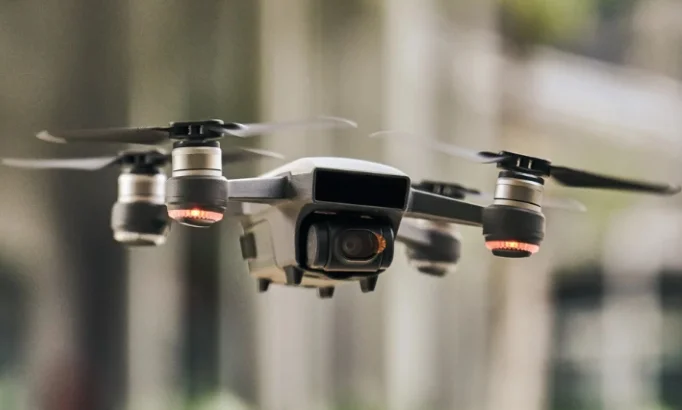
The Evolution of Unmanned Aerial Vehicles
Unmanned Aerial Vehicle (UAV), commonly called Drone, is a pilotless flying object, guided by remote control, and equipped with sensors, GPS, and camera (and now AI & ML capabilities), providing the operator with enhanced mobility and vision from their current position.
Though still a fascinating sight, it’s not uncommon anymore to see a drone hovering over a public space, capturing a cinematic shot of the geography for a content creator’s vlog. The roots, however, lie in a much more discrete territory - the military. A timeline:
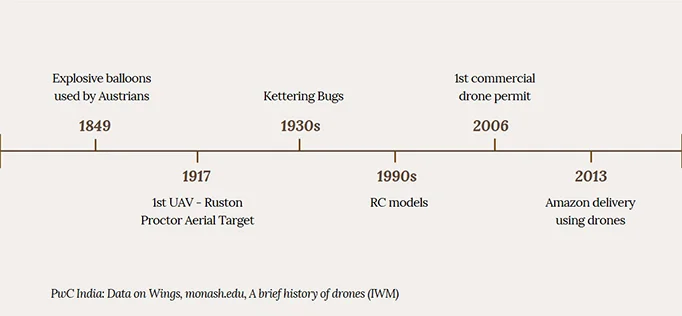
Enabling efficient processes across industries
Once commercialised, it naturally did not take long for the technology to impact a wide variety of sectors, from food to film. Which task would not be helped by the dual might of flight & sight?
- Agriculture - Detailed data on crop health and soil conditions, enabling optimised inputs, reduced waste, and increased yields through precise imaging.
- Mining - Enhanced mining safety and efficiency by detecting temperature anomalies and mapping terrain for better site management.
- Infrastructure - Facilitate industrial inspections, 3D mapping, and urban planning by providing comprehensive aerial surveys and data for construction projects.
- Disaster Management - Critical in disaster response, delivering essential supplies to remote areas where traditional transport is inaccessible.
- Surveillance and Security - Real-time monitoring for crowd control, search and rescue, and crime prevention, making them vital in security operations.
- Filmmaking and Entertainment - Revolutionised cinematography by capturing stunning aerial shots, democratising high-quality filmmaking for all creators. (and enabling Redbull to capture their unbelievable adventures)
And I am just scratching the surface. Bolstered by AI, the UAVs will continue to find more applications in more sectors. Drone-powered Amazon deliveries are not too far from reality anyway.
Every indicator points in one direction for the Drone market - skywards
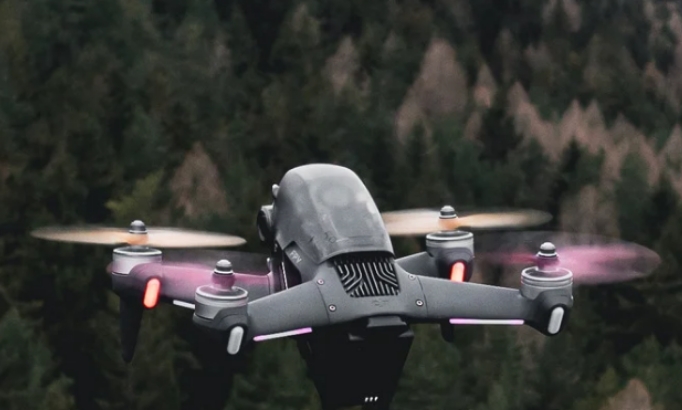
Driven by advancements in technology, increasing adoption across various sectors, and supportive government policies worldwide, as of 2024, the global drone market is valued at approximately $30 billion, with projections indicating that it could surpass $90 billion by 2030.
- The U.S. leads the world in drone technology, particularly in the military and defence sectors, with companies such as General Atomics, Boeing, and AeroVironment.
- Israel is recognized for its advanced military drone technology, with companies like Elbit Systems and Israel Aerospace Industries (IAI) being leaders in the global defence market.
- China is the largest manufacturer of consumer drones, with DJI being the dominant global player, controlling over 70% of the consumer drone market.
- In Europe, Parrot (France) and senseFly (Switzerland) are notable for their innovations, particularly in sectors like agriculture and environmental monitoring.
- Turkey has rapidly emerged as a leader in military drone technology, gaining recognition for its indigenously developed UAVs, such as Bayraktar TB2 and ANKA UAVs.
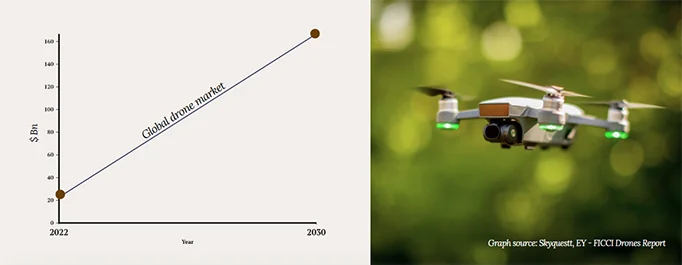
Closer to home, we have a firm sight of the drone sector as well, and the government has extended support. In 2022, at a Bharat Drone Mahotsav, the PM gave a clarion call to make India the drone hub of the world by 2030. This was followed by the Drone Shakti initiative in 2023, providing an impetus to the manufacturing of drones in India.
With the global drone market projected to reach $54 billion by 2025, India stands to capture a substantial share, potentially reaching $4.2 billion and expanding to $23 billion by 2030, as per an EY - FICCI report. “The latent availability of components within multiple elements of Indian Industry makes it feasible for the concerned industry expertise to be re-oriented towards manufacturing of drones,” states the report. There are ~400 drone startups in India today. Newspace Research and Technologies, ideaForge, DroneAcharya, General Aeronautics, Zen Technologies, TechEagle, Skye Air, Skylark Drones, Garuda Aerospace, and Botlab Dynamics, are among the top 10. (as per Tracxn)
The Ministry of Civil Aviation identified five key pillars that will allow India to be a drone hub in the next few years:
- Ease of Doing Business (Drone Rules 2021),
- financial incentives (PLI scheme),
- government as a market maker (procurement by government),
- export liberalisation and
- domestic industry promotion (Import prohibition).

Some Concerning Thoughts on Drone Tech
Intriguing as the drone-eye-view of a city may look, and as significant as the diverse impact of its applications may be, the fact that this technology has its roots in war… slows down the excitement around this innovation. Drones are only going to be an increasingly important part of wars, as is evident in the ongoing Ukraine-Russia conflict. The popular belief, that drone warfare will have lower human cost due to its ‘unmanned nature’, can be counter-intuitive.
The ability to conduct remote-controlled operations lowers the threshold for the use of force, potentially leading to more frequent military engagements. This has sparked a debate about the accountability and transparency of drone operations, as decisions to strike can be made with minimal oversight, often shrouded in secrecy.
In countries like Yemen, Pakistan, and Somalia, drone strikes aimed at militant targets have often resulted in civilian casualties. These strikes, while intended to be precise, have nonetheless caused the loss of innocent lives, leading to widespread fear and psychological trauma among local populations. In Yemen, for instance, families live under the constant threat of being targeted, which has created a pervasive sense of fear and anxiety, particularly among children.
When it comes to commercial drones, significant privacy concerns must be addressed to prevent potential misuse. The view from the sky may be informative for the viewer, but it could be an invasion of privacy of the people on the ground. Equipped with high-resolution cameras and sophisticated sensors, drones can capture detailed images and videos from above, potentially infringing on individuals' privacy without their consent.
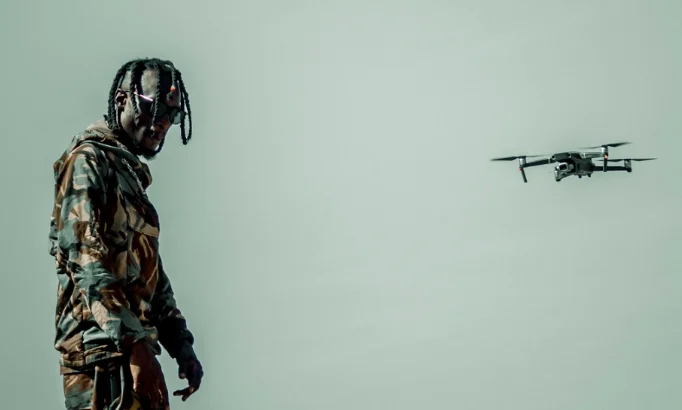
As drones become more integrated into military strategies & our public spaces, the international community must grapple with the implications for global peace, security, and human rights. This unlocked curiosity of ‘sight’ + ‘flight’ can quickly be exploited, if it is not sincerely regulated. India’s stride towards becoming the drone hub of the world must also synergize with careful regulations that caution the endeavour as much as they support it.
After all, drone tech has a glowing potential to lead us to more efficient, compassionate, and secure living, as illustrated by some of these inspiring tales I found -
- The "Medicine from the Sky" initiative in Telangana successfully delivered vaccines and critical medicines to remote villages during the COVID-19 pandemic.
- During the 2018 Kerala floods and the 2019 Cyclone Fani in Odisha, drones played a vital role in disaster response efforts.
- In Ghana, drones from Zipline have been used to deliver COVID-19 vaccines to rural communities, ensuring timely access despite the challenging logistics.
- In Vanuatu, drones successfully delivered vaccines to remote islands, a groundbreaking achievement in improving healthcare access for isolated communities.
- Some pictures by Hugo Healy, a Dubai-based drone photographer whose stunning gallery left me awestruck.
- And we are getting creative with Drones.. the Drone Show in China created waves this year.
We have so much to admire and wonder, about the world that’s provided to us, and the modern society that we are building.












.webp)



